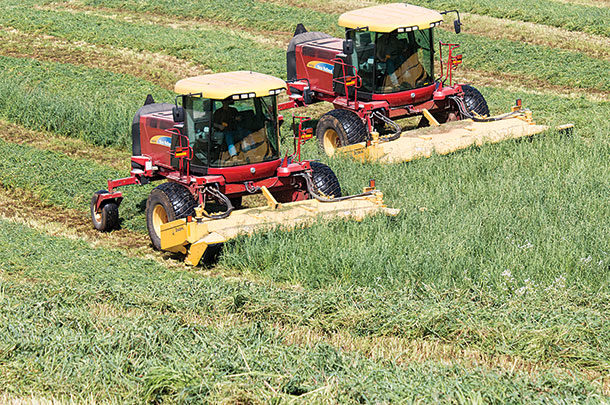For instance, if you take 1 cup of vinegar and mix it with 1 cup of baking soda, the result will be less than 2 cups as some molecules are transformed into carbon dioxide and released into the air as gas.
Or think about it this way, “If you take one boy plus one boy, you get half a boy’s worth of work.” That’s what one farmer used to say – but you could argue with his reasoning depending on the boys involved. Context means everything.
Tony Chapman and Clayton Geralds essentially farm together near Munfordville, Kentucky, and they’re a good example of one plus one not equaling two. In their equation, one plus one equals far more than two.
Chapman worked as a machinist for 26 years while farming part-time on the side. Then came a day when he decided to put pencil to paper and figure out how to quit his day job so he could farm full-time. He owned only 70 acres at that point and knew that wasn’t enough to replace his town job, although additional leased ground was obtainable. That’s when Geralds came into the picture.
Geralds, a neighboring hay producer, had been trying to convince Chapman for some time to grow alfalfa instead of using his land for cattle since there was an underserved market in the area for horse hay. Geralds told him growing alfalfa wouldn’t disappoint. Chapman decided that with Geralds’ help, he would try, and Geralds became Chapman’s mentor, teaching him the haying business.
This is where one producer with a specific skill set combined with another producer with a different skill set to forge a unique and successful enterprise. It’s an arrangement worth noting.
The farms
Geralds has 750 acres spread out in a patchwork of fields pieced together by wooded acres across Hart County. Chapman’s farm and leased acres are part of that patchwork. They raise pure alfalfa, alfalfa/orchardgrass mix, timothy and orchardgrass/fescue. Together they put up 107,000 small squares bales a year. They cut the hay together, they bale it together, and they store it together.
Geralds built two hay barns for storage, and Chapman built one barn, but they strategically placed them on the properties so that hay never has to travel more than 3 or 4 miles to a barn from any field. It doesn’t matter which barn it is or to whom it belongs, the baled hay travels to the closest barn.
Equipment is handled in much the same fashion. Chapman has a pull-type cutter, and Geralds owns two self-propelled mowers. Between them, they have six small-square balers. Then throw in a few rakes, bale wagons, sprayers and tedders. Equipment ownership isn’t split down the middle; in fact, few things about the operation are totally equal.
Production efficiency
Chapman and Geralds are both very particular about how the hay is put up. Timothy bales weigh about 50 to 53 pounds, alfalfa/orchardgrass bales weigh 60 pounds, pure alfalfa bales weigh about 65 to 70 pounds, and bale length has to be 35 inches.
Sometimes customers complain the bales are too heavy, and they’ve considered making them a little lighter – it’s usually marketed by the bale anyway, rather than by the ton, so lighter bales would indicate more profit – but Chapman says what they might gain in price they would lose in efficiency.
Chapman says their system works better with those bale weights and lengths – from the bale wagon to the grapple, stacking system to bale tightness. With that bale length, they know they can get exactly 648 bales in a 53-foot van trailer and can load it in an hour and 20 minutes with a wagon/skid-steer system Chapman and Geralds built. That efficiency adds as much profit, if not more, than making a lighter bale.
Chapman and Geralds soil test every field, every year, and use timothy as a rotation crop. They shoot for 6 tons per acre on alfalfa/orchardgrass, and if it drops below 5 tons, then it’s time to pull it out.
They also have a Kentucky Department of Agriculture specialist pull hay sample cores for testing a couple times a month. (This NFTA certified service is eligible for Kentucky producers and consumers only. If you grow hay or buy hay and live in Kentucky you are qualified for this service. For more information see: http://www.kyagr.com/marketing/Forage-Program.html)
Geralds says, “The customers don’t care about the tests; they just want green hay that looks leafy. But it’s important to us to know we’re putting up quality hay.” He also says there are customers who care very much about forage quality testing, it just happens that his customers do not.
Marketing
During haying season, they hire local help who all have to start out as “barn boys.” This means that with each stacker load, the barn worker has to lay down an 8-foot-by-12-foot piece of plastic and break a bale of straw over the top of it, then scatter the straw so no plastic is showing. (This absorbs the condensation.)
The stacker unloads, and the load is recorded on a ledger – which field it comes from and what type of hay it is. Essentially, the hay is “packaged” together from the Chapman farm and Geralds farm. But that’s OK; it’s marketed together, as well.
Geralds handles the marketing. He has a knack for customer communications and a passion for what he does, which makes him successful at it.
The bulk of the hay (90 percent) is sold to the horse market via brokers or through farm supply stores, so most of the hay leaves the farms in semi-trucks. When a semi-truck is loaded, it doesn’t matter if it’s loaded with Chapman hay or Geralds hay because it’s all consistent quality – grown and harvested the same way.

Geralds’ marketing philosophy is to keep a good customer base. He says, “If you’re just trying to sell to the highest bidder, then the customers tend to be fickle. If you ask a fair price from your regulars, you’ll keep them.” It works; they turn away new customers weekly.
Labor
On farms of unequal size with unequal equipment inputs, one might suspect a wreck when it comes to divvying out labor hours. But it isn’t a wreck with Chapman and Geralds. There are two elements in play: one boss and assigning tasks according to interest.
Chapman says, “I learned in my former job that there can be only one boss in the field.” He says he went to Geralds early in their partnership and suggested Geralds be the boss in the field; otherwise, it would be too confusing for employees to figure out who to answer to and would create inefficiency. “We meet each morning and discuss plans, but when we leave the office, Clayton is the boss,” Chapman says.
Geralds and Chapman each have sons who work with them (Chris Geralds and Will Chapman). Geralds says, “Everyone has their favorite thing to do, so if that’s what they like to do, they’ll probably do it better than anybody else. Why not have them be in charge of that?”
As a result, Geralds takes the lead on the sprayer, and Chapman runs the lime truck and fertilizer operations. They both run the self-propelled mowers and bale wagons, while sons Chris and Will take the lead on tedding, raking and baling. Each has assigned equipment, so the operator takes ownership of the equipment and runs it accordingly.
The score
It’s a genuine partnership built upon the strengths of the individual parts. Chapman brings mechanical skills, reliability and patience to the equation. Geralds says, “I could add more acres and add more equipment and grow in that respect, but what I can’t find is reliable labor.
Tony is invested in the business, and I know he’s not going anywhere. He also does things right. I don’t have to worry whether he’s mowing right or baling right or whatever. He’s a good farmer, and we do things the same way.”
Geralds provides people skills, business skills and the drive. Let’s put it this way: If it rains when hay is down, Geralds will get the ulcer. He’s the one that pushes the rest of them to put up the hay “just right.”
Geralds says, “It wouldn’t work without trust. Tony and I trust each other. If one of us made a mistake, it would be an honest mistake.”
Chapman says, “I told Clayton from the beginning I wasn’t going to keep score.”
That one principle is perhaps the key to the success of the entire operation. It’s built on trust and is fair, but is not necessarily equal. FG
PHOTO 1: In this side-by-side haying business near Munfordville, Kentucky, Tony Chapman and Clayton Geralds plant, fertilize, mow, rake, bale, stack, store and market their premium horse hay together. Photo courtesy of Lynn Jaynes.
PHOTO 2: Haying season can be intense for Tony Chapman, Clayton Geralds and their sons, Will and Chris, when the weather cooperates. Photo courtesy of Christopher Geralds.










